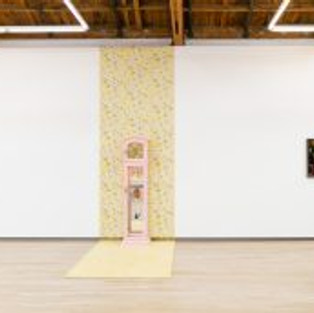
White Rain. Genevieve Gaignard. The Powder Room. Photo Courtesy of Shulamit Nazarian Gallery.
Genevieve Gaignard: The Powder Room
Shulamit Nazarian
By Jody Zellen
Through May 20th
Why do so many women use the genre of photographic self portraiture to explore issues of identity and race? Artists including Cindy Sherman, Nikki S. Lee and Tomoko Sawada have transformed their appearance by donning various costumes, changing hairstyles and applications of make up. Often the photographs they create confront stereotypical representations of women, particularly women of color. New to this ever growing field is Yale educated and now Los Angeles based photographer Genevieve Gaignard. In her exhibition The Powder Room, she presents herself as both white and black women, performing roles that continue her investigations into social constructions that relate to her identity as a biracial woman.

Get Out. Genevieve Gaignard. The Powder Room. Photo Courtesy of Shulamit Nazarian Gallery.
Gaignard looks to the past in her large format color photographs, embracing the styles and palette of the 1950s —a mid century camp— a.k.a. John Waters and situates her characters inside and outside various domestic spaces. The woman she becomes in “Get Out,” “Elephant in the Room” and “Neighborhood Watch” is a mid 20th century housewife who waters her manicured lawn while keeping an eye out for danger. She sports a blond wig with wavy hair piled high in a bob and wears a pleated beige skirt, brown short-sleeved top and tan pumps which she has taken off to water the front yard. In “Get Out,” she glares at the camera as if it was an intruder suggesting how dare you set foot in my neighborhood. Similarly, in “Neighborhood Watch” she is seen peering out a side window of her home protected behind the pane of glass. “Elephant in the Room,” moves the action to the interior of the home. Here Gaignard sits complacently and resigned in a carpeted den on a rust colored couch covered in plastic. The wall behind her is wallpapered with the natural landscape —a tree lined forest in autumn. Positioned between the faux landscape and the seated woman, a smiling toy monkey sits on top of the couch. Both subjects are uncomfortable in this environment and are in essence, elephants in the room. “Hidden Fences” and “Lace Front Lawn” also depict Gaignard as a white suburbanite in front of a white house with blue shutters and a perfect green lawn. The discomfort is apparent in the woman’s gaze as if to say, ‘don’t find me out.’
In the seven photographs entitled “The Line Up,” the artist presents herself as busty African American women dressed in their Sunday best. Each portrait is shot in direct sunlight against a colored wall (orange, green, powder blue, cream, tan, gray and white). These images are of stoic and empowered individuals who say ‘look at me’ as opposed to Gaignard’s depictions of the white housewives who seem out of place and uncomfortable in their own skin. It is significant that Gaignard is both the creator and subject of these works— that it is her body and skin color that is under scrutiny. She changes her costume, hair and make up as if to say: here I am white, here I am black, yet it is all me.
Gaignard uses photography to explore binaries —specifically the relationship between black and white— and has a great time doing so. Rather than turn her camera on others in real spaces, Gaignard invents characters whose body and personalities she can inhabit and places them into settings and scenarios in which she has complete control. Rather than exhibit her photographs on blank white walls Gaignard often presents them as an installation, in this case hanging on antique floral wallpaper. The photographs are also presented in conjunction with sculptural tableaux that juxtapose found and personal artifacts including what we now term ‘racist’ statuettes that obliquely reference her upbringing and heritage.

Selfie Stick. Genevieve Gaignard. The Powder Room. Photo Courtesy of Shulamit Nazarian Gallery.
Gaignard explores self representation in myriad ways and acknowledges that technology has made self portraiture commonplace. The tongue and cheek wall sculpture entitled “Selfie Stick,” is an installation of antique hand mirrors of varying shapes and sizes. These beautiful mirrored objects are what women used to check their appearance before the advent of cell phones with front facing lenses. Women embrace the genre of photographic self portraiture because it gives them control over their self image. They can be whomever they want and they can indulge their fantasies by saying look at me, see me, made up or stripped down, no matter how beautiful or ugly, fat or thin I may be. When captured and presented within the photographic rubric, I demand attention, I demand to be seen and taken seriously… I reign.
#losangeles #california #GenevieveGaignard #art #fineartphotography #losangelesart #contemporaryart #cindysherman #southerncalifornia #JodyZellen #photography #artgallery #ShulamitNazarian #artandcake #TomokoSawada #soloexhibition #artexhibition #installation #ArtandCakeLA #fineart #ThePowderRoom #artist #mixedmedia #arts #artreview #installationart #artexhibit #ArtandCulture #exhibition #exhibit #NikkiSLee #dtla #losangelesgallery


































